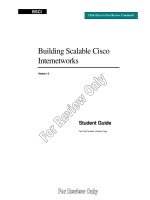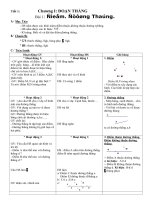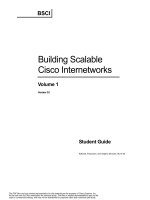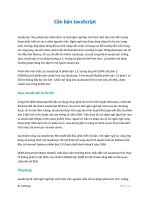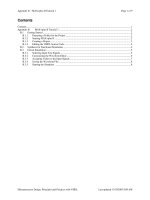Tài liệu Building Scalable Cisco Internetworks - Volume 1 docx
Bạn đang xem bản rút gọn của tài liệu. Xem và tải ngay bản đầy đủ của tài liệu tại đây (6.14 MB, 430 trang )
BSCI
Building Scalable
Cisco Internetworks
Volume 1
Version 3.0
Student Guide
Editorial, Production, and Graphic Services: 06.14.06
The PDF files and any printed representation for this material are the property of Cisco Systems, Inc.,
for the sole use by Cisco employees for personal study. The files or printed representations may not be
used in commercial training, and may not be distributed for purposes other than individual self-study.
Corporate Headquarters
Cisco Systems, Inc.
170 West Tasman Drive
San Jose, CA 95134-1706
USA
www.cisco.com
Tel: 408 526-4000
800 553-NETS (6387)
Fax: 408 526-4100
European Headquarters
Cisco Systems International BV
Haarlerbergpark
Haarlerbergweg 13-19
1101 CH Amsterdam
The Netherlands
www-europe.cisco.com
Tel: 31 0 20 357 1000
Fax: 31 0 20 357 1100
Americas Headquarters
Cisco Systems, Inc.
170 West Tasman Drive
San Jose, CA 95134-1706
USA
www.cisco.com
Tel: 408 526-7660
Fax: 408 527-0883
Asia Pacific Headquarters
Cisco Systems, Inc.
168 Robinson Road
#28-01 Capital Tower
Singapore 068912
www.cisco.com
Tel: +65 6317 7777
Fax: +65 6317 7799
Cisco Systems has more than 200 offices in the following countries and regions. Addresses, phone numbers, and fax numbers are listed on the
C i s c o . c o m W e b s i t e a t w w w . c i s c o . c o m / g o / o f f i c e s .
Argentina • Australia • Austria • Belgium • Brazil • Bulgaria • Canada • Chile • China PRC • Colombia • Costa Rica • Croatia • Cyprus • Czech Republic •
Denmark • Dubai, UAE • Finland • France • Germany • Greece • Hong Kong SAR • Hungary • India • Indonesia • Ireland
Israel • Italy • Japan • Korea • Luxembourg • Malaysia • Mexico • The Netherlands • New Zealand • Norway • Peru • Philippines
Poland • Portugal • Puerto Rico • Romania • Russia • Saudi Arabia • Scotland • Singapore • Slovakia • Slovenia • South Africa
Spain • Sweden • Switzerland • Taiwan • Thailand • Turkey • Ukraine • United Kingdom • United States • Venezuela • Vietnam • Zimbabwe
© 2006 Cisco Systems, Inc. All rights reserved. CCSP, CCVP, the Cisco Square Bridge logo, Follow Me Browsing, and StackWise are trademarks of
Cisco Systems, Inc.; Changing the Way We Work, Live, Play, and Learn, and iQuick Study are service marks of Cisco Systems, Inc.; and Access
Registrar, Aironet, BPX, Catalyst, CCDA, CCDP, CCIE, CCIP, CCNA, CCNP, Cisco, the Cisco Certified Internetwork Expert logo, Cisco IOS, Cisco Press,
Cisco Systems, Cisco Systems Capital, the Cisco Systems logo, Cisco Unity, Enterprise/Solver, EtherChannel, EtherFast, EtherSwitch, Fast Step, FormShare,
GigaDrive, GigaStack, HomeLink, Internet Quotient, IOS, IP/TV, iQ Expertise, the iQ logo, iQ Net Readiness Scorecard, LightStream, Linksys, MeetingPlace,
MGX, the Networkers logo, Networking Academy, Network Registrar, Packet, PIX, Post-Routing, Pre-Routing, ProConnect, RateMUX, ScriptShare,
SlideCast, SMARTnet, The Fastest Way to Increase Your Internet Quotient, and TransPath are registered trademarks of Cisco Systems, Inc. and/or its affiliates
in the United States and certain other countries.
All other trademarks mentioned in this document or Website are the property of their respective owners. The use of the word partner does not imply a
partnership relationship between Cisco and any other company. (0601R)
DISCLAIMER WARRANTY: THIS CONTENT IS BEING PROVIDED “AS IS.” CISCO MAKES AND YOU RECEIVE NO WARRANTIES IN
CONNECTION WITH THE CONTENT PROVIDED HEREUNDER, EXPRESS, IMPLIED, STATUTORY OR IN ANY OTHER PROVISION OF
THIS CONTENT OR COMMUNICATION BETWEEN CISCO AND YOU. CISCO SPECIFICALLY DISCLAIMS ALL IMPLIED
WARRANTIES, INCLUDING WARRANTIES OF MERCHANTABILITY, NON-INFRINGEMENT AND FITNESS FOR A PARTICULAR
PURPOSE, OR ARISING FROM A COURSE OF DEALING, USAGE OR TRADE PRACTICE. This learning product may contain early release
content, and while Cisco believes it to be accurate, it falls subject to the disclaimer above.
The PDF files and any printed representation for this material are the property of Cisco Systems, Inc.,
for the sole use by Cisco employees for personal study. The files or printed representations may not be
used in commercial training, and may not be distributed for purposes other than individual self-study.
Students, this letter describes important
course evaluation access information!
Welcome to Cisco Systems Learning. Through the Cisco Learning Partner Program,
Cisco Systems is committed to bringing you the highest-quality training in the industry.
Cisco learning products are designed to advance your professional goals and give you the
expertise you need to build and maintain strategic networks.
Cisco relies on customer feedback to guide business decisions; therefore, your valuable
input will help shape future Cisco course curricula, products, and training offerings.
We would appreciate a few minutes of your time to complete a brief Cisco online course
evaluation of your instructor and the course materials in this student kit. On the final day
of class, your instructor will provide you with a URL directing you to a short post-course
evaluation. If there is no Internet access in the classroom, please complete the evaluation
within the next 48 hours or as soon as you can access the web.
On behalf of Cisco, thank you for choosing Cisco Learning Partners for your Internet
technology training.
Sincerely,
Cisco Systems Learning
The PDF files and any printed representation for this material are the property of Cisco Systems, Inc.,
for the sole use by Cisco employees for personal study. The files or printed representations may not be
used in commercial training, and may not be distributed for purposes other than individual self-study.
The PDF files and any printed representation for this material are the property of Cisco Systems, Inc.,
for the sole use by Cisco employees for personal study. The files or printed representations may not be
used in commercial training, and may not be distributed for purposes other than individual self-study.
Table of Contents
Volume 1
Course Introduction 1
Overview 1
Learner Skills and Knowledge 1
Course Goal and Objectives 2
Course Flow 3
Additional References 4
Cisco Glossary of Terms 4
Your Training Curriculum 5
Network Requirements 1-1
Overview 1-1
Module Objectives 1-1
Describing Network Requirements 1-3
Overview 1-3
Objectives 1-3
Cisco Network Models 1-4
Enterprise Composite Network Model 1-8
Traffic Conditions in a Converged Network 1-10
Cisco SONA Framework and IIN 1-11
Routing and Routing Protocols 1-15
Summary 1-17
References 1-17
Configuring EIGRP 2-1
Overview 2-1
Module Objectives 2-1
Introducing EIGRP 2-3
Overview 2-3
Objectives 2-3
EIGRP Capabilities and Attributes 2-4
Underlying Processes and Technologies 2-6
EIGRP Operation 2-8
Example: EIGRP Tables 2-12
EIGRP Metric 2-15
Calculating the EIGRP Metric 2-16
Example: EIGRP Metric Calculation 2-18
Integrating the EIGRP and IGRP Routes 2-20
Summary 2-21
Implementing and Verifying EIGRP 2-23
Overview 2-23
Objectives 2-23
Configuring Basic EIGRP 2-24
Example: Configuring EIGRP for IP 2-27
Using a Wildcard Mask in EIGRP 2-29
Example: Wildcard Mask in EIGRP 2-29
Configuring the ip default-network Command 2-30
Example: ip default-network Command 2-31
Verify EIGRP IP Routes 2-32
Example: EIGRP Configuration 2-32
Example: R2 EIGRP Configuration 2-33
Verify EIGRP IP Operations 2-37
Summary 2-43
The PDF files and any printed representation for this material are the property of Cisco Systems, Inc.,
for the sole use by Cisco employees for personal study. The files or printed representations may not be
used in commercial training, and may not be distributed for purposes other than individual self-study.
ii Building Scalable Cisco Internetworks (BSCI) v3.0 © 2006 Cisco Systems, Inc.
Configuring Advanced EIGRP Options 2-45
Overview 2-45
Objectives 2-45
Route Summarization 2-46
Configuring Manual Route Summarization 2-49
Example: Summarizing EIGRP Routes 2-50
Example: Router C Routing Table 2-51
Load Balancing Across Equal Paths 2-52
Configuring Load Balancing Across Unequal-Cost Paths 2-53
Example: Variance 2-54
EIGRP Bandwidth Use Across WAN Links 2-56
Configuring EIGRP Bandwidth Use Across WAN Links 2-59
Example: WAN Configuration—Frame Relay Hub-and-Spoke Topology 2-59
Example: WAN Configuration–Hybrid Multipoint 2-61
Summary 2-62
Configuring EIGRP Authentication 2-63
Overview 2-63
Objectives 2-63
Router Authentication 2-64
MD5 Authentication 2-66
Configuring MD5 Authentication 2-68
Example: MD5 Authentication Configuration 2-73
Example: R1 Configuration for MD5 Authentication 2-74
Example: R2 Configuration for MD5 Authentication 2-75
Verifying MD5 Authentication 2-76
Troubleshooting MD5 Authentication 2-77
Example: Successful MD5 Authentication 2-77
Example: Troubleshooting MD5 Authentication Problems 2-78
Summary 2-79
Using EIGRP in an Enterprise Network 2-81
Overview 2-81
Objectives 2-81
Scalability in Large Networks 2-82
EIGRP Queries 2-83
EIGRP Stubs 2-84
Example: Limiting Updates and Queries: Using EIGRP Stub 2-88
Example: eigrp stub Parameters 2-89
SIA Connections 2-91
Preventing SIA Connections 2-92
Graceful Shutdown 2-94
Summary 2-96
Module Summary 2-97
Module Self-Check 2-99
Module Self-Check Answer Key 2-108
Configuring OSPF 3-1
Overview 3-1
Module Objectives 3-1
The PDF files and any printed representation for this material are the property of Cisco Systems, Inc.,
for the sole use by Cisco employees for personal study. The files or printed representations may not be
used in commercial training, and may not be distributed for purposes other than individual self-study.
© 2006 Cisco Systems, Inc. Building Scalable Cisco Internetworks (BSCI) v3.0 iii
Introducing the OSPF Protocol 3-3
Overview 3-3
Objectives 3-3
Link-State Routing Protocols 3-4
OSPF Area Structure 3-7
OSPF Adjacency Databases 3-10
Calculating the OSPF Metric 3-13
Example: SPF Calculation 3-14
Link-State Data Structures 3-15
Summary 3-16
OSPF Packet Types 3-17
Overview 3-17
Objectives 3-17
OSPF Packet Types 3-18
Establishing OSPF Neighbor Adjacencies 3-20
Exchanging and Synchronizing LSDBs 3-22
Maintaining Network Routes 3-26
Maintaining Link-State Sequence Numbers 3-28
Example: LSA Sequence Numbers and Maximum Age 3-29
Verifying Packet Flow 3-30
Example: debug ip ospf packet 3-30
Summary 3-32
Configuring OSPF Routing 3-33
Overview 3-33
Objectives 3-33
Configuring Basic Single-Area and Multiarea OSPF 3-34
Example: Configuring OSPF on Internal Routers of a Single Area 3-36
Example: Configuring OSPF for Multiple Areas 3-37
Configuring a Router ID 3-38
Verifying the OSPF Router ID 3-41
Verifying OSPF Operation 3-43
Example: The show ip route ospf Command 3-45
Example: The show ip ospf interface Command 3-46
Example: The show ip ospf neighbor Command 3-47
Summary 3-49
OSPF Network Types 3-51
Overview 3-51
Objectives 3-51
Introducing OSPF Network Types 3-52
Adjacency Behavior for a Point-to-Point Link 3-53
Adjacency Behavior for a Broadcast Network Link 3-54
Selecting the DR and BDR 3-56
Adjacency Behavior for an NBMA Network 3-58
OSPF over Frame Relay Configuration Options 3-60
Example: Sample Configuration of a Router Using OSPF Broadcast Mode 3-63
OSPF over Frame Relay NBMA Configuration 3-64
Example: neighbor Command 3-66
Example: show ip ospf neighbor Command 3-67
OSPF over Frame Relay Point-to-Multipoint Configuration 3-68
Example: Point-to-Multipoint Configuration 3-69
Using Subinterfaces in OSPF over Frame Relay Configuration 3-72
Example: Point-to-Point Subinterface 3-74
Example: Multipoint Subinterface 3-76
Example: OSPF over NBMA Topology Summary 3-77
The PDF files and any printed representation for this material are the property of Cisco Systems, Inc.,
for the sole use by Cisco employees for personal study. The files or printed representations may not be
used in commercial training, and may not be distributed for purposes other than individual self-study.
iv Building Scalable Cisco Internetworks (BSCI) v3.0 © 2006 Cisco Systems, Inc.
Tracking OSPF Adjacencies 3-78
Example: debug Output for Point-to-Point Mode 3-78
Example: debug ip ospf adj Output for Broadcast Mode 3-79
Summary 3-82
Link-State Advertisements 3-83
Overview 3-83
Objectives 3-83
OSPF Router Types 3-84
Example: OSPF Hierarchical Routing 3-85
OSPF Virtual Links 3-88
Example: OSPF Virtual Link Configuration 3-91
Example: show ip ospf virtual-links Command 3-92
OSPF LSA Types 3-95
Type 1 3-95
Type 2 3-95
Types 3 and 4 3-96
Type 5 3-96
Type 6 3-96
Type 7 3-96
Type 8 3-96
Types 9, 10, and 11 3-96
Example: LSA Type 4—Summary LSA 3-100
Interpreting the OSPF LSDB and Routing Table 3-102
Example: Interpreting the OSPF Database 3-102
Configuring OSPF LSDB Overload Protection 3-108
Changing the Cost Metric 3-110
Summary 3-111
OSPF Route Summarization 3-113
Overview 3-113
Objectives 3-113
OSPF Route Summarization 3-114
Example: Using Route Summarization 3-116
Configuring OSPF Route Summarization 3-117
Example: Route Summarization Configuration at ABR 3-119
Example: Route Summarization Configuration at ASBR 3-120
Benefits of a Default Route in OSPF 3-121
Example: Default Routes in OSPF 3-121
Configuring a Default Route in OSPF 3-122
Example: Default Route Configuration 3-124
Summary 3-125
Configuring OSPF Special Area Types 3-127
Overview 3-127
Objectives 3-127
Configuring OSPF Area Types 3-128
Configuring Stub Areas 3-130
Example: OSPF Stub Area Configuration 3-133
Configuring Totally Stubby Areas 3-134
Example: Totally Stubby Configuration 3-136
Interpreting Routing Tables 3-137
Example: Routing Table in a Standard Area 3-137
Example: Routing Table in a Stub Area 3-138
Example: Routing Table in a Stub Area with Summarization 3-139
Example: Routing Table in a Totally Stubby Area 3-140
Configuring NSSAs 3-141
Example: NSSA Configuration 3-144
Example: NSSA Totally Stubby Configuration 3-145
The PDF files and any printed representation for this material are the property of Cisco Systems, Inc.,
for the sole use by Cisco employees for personal study. The files or printed representations may not be
used in commercial training, and may not be distributed for purposes other than individual self-study.
© 2006 Cisco Systems, Inc. Building Scalable Cisco Internetworks (BSCI) v3.0 v
Verifying All Stub Area Types 3-146
Summary 3-147
Configuring OSPF Authentication 3-149
Overview 3-149
Objectives 3-149
Types of Authentication 3-150
Configuring Simple Password Authentication 3-151
Example: Simple Password Authentication Configuration 3-153
Example: R2 Configuration for Simple Password Authentication 3-154
Verifying Simple Password Authentication 3-155
Configuring MD5 Authentication 3-156
Example: MD5 Authentication Configuration 3-159
Example: R2 Configuration for MD5 Authentication 3-160
Verifying MD5 Authentication 3-161
Troubleshooting Simple Password Authentication 3-162
Example: Successful Simple Password Authentication 3-162
Example: Troubleshooting Simple Password Authentication Problems 3-164
Troubleshooting MD5 Authentication 3-165
Example: Successful MD5 Authentication 3-165
Example: Troubleshooting MD5 Authentication Problems 3-167
Summary 3-168
Module Summary 3-169
Module Self-Check 3-171
Module Self-Check Answer Key 3-188
The IS-IS Protocol 4-1
Overview 4-1
Module Objectives 4-1
Introducing IS-IS and Integrated IS-IS Routing 4-3
Overview 4-3
Objectives 4-3
IS-IS Routing 4-4
Integrated IS-IS Routing 4-8
Principles and Issues of Integrated IS-IS Design 4-9
The ES-IS Protocol 4-11
OSI Routing Levels 4-13
Level 0 Routing 4-13
IS-IS Level 1 Routing 4-13
IS-IS Level 2 Routing 4-14
Level 3 Routing 4-14
Summary of Routing Levels 4-14
Comparing IS-IS to OSPF 4-15
Summary of Differences between OSPF and Integrated IS-IS 4-19
Summary 4-20
The PDF files and any printed representation for this material are the property of Cisco Systems, Inc.,
for the sole use by Cisco employees for personal study. The files or printed representations may not be
used in commercial training, and may not be distributed for purposes other than individual self-study.
vi Building Scalable Cisco Internetworks (BSCI) v3.0 © 2006 Cisco Systems, Inc.
Performing IS-IS Routing Operations 4-21
Overview 4-21
Objectives 4-21
NSAP Addresses 4-22
NET Addresses 4-28
IS-IS Routing Levels 4-30
Intra-Area and Interarea Addressing and Routing 4-31
Example: Identifying Systems—OSI Addressing in Networks 4-33
Example: OSI Area Routing 4-34
IS-IS PDUs 4-37
Link-State Packets 4-39
Example: LSP TLV Examples 4-41
Implementing IS-IS in NBMA Networks 4-42
Implementing IS-IS in Broadcast Networks 4-44
LSP and IIH Levels 4-47
Level 1 and Level 2 LSP 4-47
Level 1 and Level 2 IIH 4-47
Example: Comparing Broadcast and Point-to-Point Topologies 4-49
LSDB Synchronization 4-50
Example: LSDB Synchronization—LAN 4-52
Example: LSDB Synchronization: Point-to-Point 4-53
Example: WAN Adjacencies 4-55
Summary 4-56
Configuring Basic Integrated IS-IS 4-57
Overview 4-57
Objectives 4-57
Integrated IS-IS in a CLNS Environment 4-58
Configuring Integrated IS-IS 4-61
Example: Simple Integrated IS-IS Configuration 4-66
Optimizing IS-IS 4-67
Example: Tuning IS-IS Configuration 4-70
Configuring Route Summarization in IS-IS 4-71
Verifying IS-IS Configuration 4-72
Example: Is Integrated IS-IS Running? 4-72
Verifying CLNS IS-IS Structures 4-74
Example: OSI Intra-Area and Interarea Routing 4-76
Summary 4-80
Module Summary 4-81
References 4-81
Module Self-Check 4-83
Module Self-Check Answer Key 4-92
Example: WAN Adjacencies 4-94
The PDF files and any printed representation for this material are the property of Cisco Systems, Inc.,
for the sole use by Cisco employees for personal study. The files or printed representations may not be
used in commercial training, and may not be distributed for purposes other than individual self-study.
BSCI
Course Introduction
Overview
Building Scalable Cisco Internetworks (BSCI) v3.0 is recommended training for individuals
seeking Cisco CCNP
®
certification. The course instructs network administrators of medium-to-
large network sites on the use of advanced routing in implementing scalability for Cisco routers
that are connected to LANs and WANs. The goal is to train network administrators to
dramatically increase the number of routers and sites using these techniques instead of
redesigning the network when additional sites or wiring configurations are added.
Learner Skills and Knowledge
This topic lists the skills and knowledge that learners must possess to benefit fully from the
course.
© 2006 Cisco Systems, Inc. All rights reserved. BSCI v3.0—1-2
Learner Skills and Knowledge
Cisco CCNA
®
certification
Note: Practical experience with deploying and operating
networks based on Cisco network devices and Cisco IOS
software is strongly recommended.
The PDF files and any printed representation for this material are the property of Cisco Systems, Inc.,
for the sole use by Cisco employees for personal study. The files or printed representations may not be
used in commercial training, and may not be distributed for purposes other than individual self-study.
2 Building Scalable Cisco Internetworks (BSCI) v3.0 © 2006 Cisco Systems, Inc.
Course Goal and Objectives
This topic describes the course goal and objectives.
© 2006 Cisco Systems, Inc. All rights reserved. BSCI v3.0—1-3
“To train network administrators on the techniques to
plan, implement, and monitor a scalable IP routing
network.”
Building Scalable Cisco Internetworks
Course Goal
Upon completing this course, you will be able to meet these objectives:
̈ Describe the converged network requirements of various network and networked
applications within the Cisco network architectures
̈ Implement and verify EIGRP operations
̈ Build a scalable multiarea network with OSPF
̈ Configure Integrated IS-IS in a single area
̈ Manipulate routing and packet flow
̈ Implement and verify BGP for enterprise ISP connectivity
̈ Implement and verify multicast forwarding using PIM and related protocols
̈ Describe how IPv6 functions to satisfy the increasingly complex requirements of
hierarchical addressing
The PDF files and any printed representation for this material are the property of Cisco Systems, Inc.,
for the sole use by Cisco employees for personal study. The files or printed representations may not be
used in commercial training, and may not be distributed for purposes other than individual self-study.
© 2006 Cisco Systems, Inc. Course Introduction 3
Course Flow
This topic presents the suggested flow of the course materials.
© 2006 Cisco Systems, Inc. All rights reserved. BSCI v3.0—1-4
Course Flow
Configuring
EIGRP
Course
Introduction
Lunch
A
M
P
M
Day 1 Day 2 Day 3 Day 4 Day 5
Manipulating
Routing
Updates
Implementing
Multicast
Network
Requirements
Configuring
EIGRP
Configuring
OSPF
Configuring
OSPF
The IS-IS
Protocol
Implementing
BGP
Implementing
BGP
Implementing
IPv6
The schedule reflects the recommended structure for this course. This structure allows enough
time for the instructor to present the course information and for you to work through the lab
activities. The exact timing of the subject materials and labs depends on the pace of your
specific class.
The PDF files and any printed representation for this material are the property of Cisco Systems, Inc.,
for the sole use by Cisco employees for personal study. The files or printed representations may not be
used in commercial training, and may not be distributed for purposes other than individual self-study.
4 Building Scalable Cisco Internetworks (BSCI) v3.0 © 2006 Cisco Systems, Inc.
Additional References
This topic presents the Cisco icons and symbols used in this course, as well as information on
where to find additional technical references.
© 2006 Cisco Systems, Inc. All rights reserved. BSCI v3.0—1-5
Cisco Icons and Symbols
Router
Network
Cloud
End Users
Serial Link
Circuit-Switched Link
Ethernet
PC
Laptop
File
Server
Web
Server
Cisco Glossary of Terms
For additional information on Cisco terminology, refer to the Cisco Internetworking Terms and
Acronyms glossary of terms at
The PDF files and any printed representation for this material are the property of Cisco Systems, Inc.,
for the sole use by Cisco employees for personal study. The files or printed representations may not be
used in commercial training, and may not be distributed for purposes other than individual self-study.
© 2006 Cisco Systems, Inc. Course Introduction 5
Your Training Curriculum
This topic presents the training curriculum for this course.
© 2006 Cisco Systems, Inc. All rights reserved. BSCI v3.0—1-6
Cisco Career Certifications
Expand Your Professional Options
and Advance Your Career
CCNP
Professional
CCIE
CCNP
CCNP
CCNA
CCNA
Associate
/>Recommended Training Through
Cisco Learning Partners
Required
Exam
642-901
BSCI
642-812
BCMSN
642-821
ISCW
Building Scalable Cisco
Internetworks
Building Cisco Multilayer
Switched Networks
Implementing Secure
Converged Wide-Area Networks
Optimizing Converged
Cisco Networks
642-845
ONT
Expert
You are encouraged to join the Cisco Certification Community, a discussion forum open to
anyone holding a valid Cisco Career Certification (such as Cisco CCIE
®
, CCNA
®
, CCDA
®
,
CCNP
®
, CCDP
®
, CCIP
®
, CCSP™, or CCVP™). It provides a gathering place for Cisco
certified professionals to share questions, suggestions, and information about Cisco Career
Certification programs and other certification-related topics. For more information, visit
The PDF files and any printed representation for this material are the property of Cisco Systems, Inc.,
for the sole use by Cisco employees for personal study. The files or printed representations may not be
used in commercial training, and may not be distributed for purposes other than individual self-study.
6 Building Scalable Cisco Internetworks (BSCI) v3.0 © 2006 Cisco Systems, Inc.
© 2006 Cisco Systems, Inc. All rights reserved. BSCI v3.0—1-7
Learner Introductions
• Your name
• Your company
• Skills and
knowledge
• Brief history
• Objective
Please introduce yourself to the class.
The PDF files and any printed representation for this material are the property of Cisco Systems, Inc.,
for the sole use by Cisco employees for personal study. The files or printed representations may not be
used in commercial training, and may not be distributed for purposes other than individual self-study.
Module 1
Network Requirements
Overview
The convergence of voice, video, and data has not only changed the conceptual network models
but has also affected the way that networks support services and applications.
This module describes Cisco conceptual models and architectures for converged networks.
Module Objectives
Upon completing this module, you will be able to describe the converged network requirements
of various network and networked applications within the Cisco network architectures.
The PDF files and any printed representation for this material are the property of Cisco Systems, Inc.,
for the sole use by Cisco employees for personal study. The files or printed representations may not be
used in commercial training, and may not be distributed for purposes other than individual self-study.
1-2 Building Scalable Cisco Internetworks (BSCI) v3.0 © 2006 Cisco Systems, Inc.
The PDF files and any printed representation for this material are the property of Cisco Systems, Inc.,
for the sole use by Cisco employees for personal study. The files or printed representations may not be
used in commercial training, and may not be distributed for purposes other than individual self-study.
Lesson 1
Describing Network
Requirements
Overview
This lesson starts by introducing Cisco Enterprise Architectures and describing how they align
with the traditional three-layer hierarchical network model. The Cisco Enterprise Composite
Network Model is examined, and the traffic patterns in converged networks are discussed. The
Cisco vision of the future Intelligent Information Network (IIN) and the Service-Oriented
Network Architecture (SONA) are introduced. The lesson concludes with a discussion of where
routing protocols fit into these models.
Objectives
Upon completing this lesson, you will be able to describe the converged network requirements
of various network and networked applications within the Cisco network architectures. This
ability includes being able to meet these objectives:
̈ Explain the Cisco conceptual network models, such as Cisco Enterprise Architectures and
the Cisco hierarchical network model
̈ Describe the Cisco Enterprise Composite Network Model
̈ Describe the traffic conditions in a converged network
̈ Describe the IIN and the Cisco SONA framework
̈ Describe routing and routing protocols
The PDF files and any printed representation for this material are the property of Cisco Systems, Inc.,
for the sole use by Cisco employees for personal study. The files or printed representations may not be
used in commercial training, and may not be distributed for purposes other than individual self-study.
1-4 Building Scalable Cisco Internetworks (BSCI) v3.0 © 2006 Cisco Systems, Inc.
Cisco Network Models
This topic describes Cisco network models, starting with the Cisco Enterprise Architectures and
their mapping to traditional three-layer hierarchical network model.
© 2006 Cisco System s, Inc. All rights reserved. BSCI v3.0—1-2
Cisco Enterprise Architectures
Cisco provides an enterprise-wide systems architecture that helps companies to protect,
optimize, and grow the infrastructure that supports their business processes. The architecture
provides for integration of the entire network—campus, data center, WAN, branches, and
teleworkers—offering staff secure access to tools, processes, and services.
The Cisco Enterprise Campus Architecture combines a core infrastructure of intelligent
switching and routing with tightly integrated productivity-enhancing technologies, including IP
communications, mobility, and advanced security. The architecture provides the enterprise with
high availability through a resilient multilayer design, redundant hardware and software
features, and automatic procedures for reconfiguring network paths when failures occur.
Multicast provides optimized bandwidth consumption, and quality of service (QoS) prevents
oversubscription to ensure that real-time traffic, such as voice and video, or critical data is not
dropped or delayed. Integrated security protects against and mitigates the impact of worms,
viruses, and other attacks on the network—even at the port level. Cisco enterprise-wide
architecture extends support for standards, such as 802.1x and Extensible Authentication
Protocol (EAP). It also provides the flexibility to add IPsec and Multiprotocol Label Switching
(MPLS) virtual private networks (VPNs), identity and access management, and VLANs to
compartmentalize access. These features help improve performance and security and decrease
costs.
The PDF files and any printed representation for this material are the property of Cisco Systems, Inc.,
for the sole use by Cisco employees for personal study. The files or printed representations may not be
used in commercial training, and may not be distributed for purposes other than individual self-study.
© 2006 Cisco Systems, Inc. Describing Network Requirements 1-5
The Cisco Enterprise Data Center Architecture is a cohesive, adaptive network architecture that
supports the requirements for consolidation, business continuance, and security while enabling
emerging service-oriented architectures, virtualization, and on-demand computing. IT staff can
easily provide departmental staff, suppliers, or customers with secure access to applications and
resources, which simplifies and streamlines management, significantly reducing overhead.
Redundant data centers provide backup using synchronous and asynchronous data and
application replication. The network and devices offer server and application load balancing to
maximize performance. This solution allows the enterprise to scale without major changes to
the infrastructure.
The Cisco Enterprise Branch Architecture allows enterprises to extend head-office applications
and services, such as security, IP communications, and advanced application performance to
thousands of remote locations and users or to a small group of branches. Cisco integrates
security, switching, network analysis, caching, and converged voice and video services into a
series of integrated services routers in the branch so that the enterprises can deploy new
services when they are ready without buying new equipment. This solution provides secure
access to voice, mission-critical data, and video applications—anywhere, anytime. Advanced
network routing, VPNs, redundant WAN links, application content caching, and local IP
telephony call processing provide a robust architecture with high levels of resilience for all the
branch offices. An optimized network leverages the WAN and LAN to reduce traffic and save
bandwidth and operational expenses. The enterprise can easily support branch offices with the
ability to centrally configure, monitor, and manage devices located at remote sites, including
tools such as AutoQoS that proactively resolve congestion and bandwidth issues before they
affect network performance.
The Cisco Enterprise Teleworker Architecture allows enterprises to securely deliver voice and
data services to remote small or home offices over a standard broadband access service,
providing a business resiliency solution for the enterprise and a flexible work environment for
employees. Centralized management minimizes the IT support costs, and robust integrated
security mitigates the unique security challenges of this environment. Integrated security and
identity-based networking services enable the enterprise to help extend campus security
policies to the teleworker. Staff can securely log in to the network over an “always-on” VPN
and gain access to authorized applications and services from a single cost-effective platform.
Productivity can further be enhanced by adding an IP phone, providing cost-effective access to
a centralized IP communications system with voice and unified messaging services.
The Cisco Enterprise WAN Architecture offers the convergence of voice, video, and data
services over a single IP communications network, which enables the enterprise to cost-
effectively span large geographic areas. QoS, granular service levels, and comprehensive
encryption options help ensure the secure delivery of high-quality corporate voice, video, and
data resources to all corporate sites, enabling staff to work productively and efficiently
wherever they are located. Security is provided with multiservice VPNs (IPsec and MPLS) over
Layer 2 or Layer 3 WANs or hub-and-spoke or full-mesh topologies.
The PDF files and any printed representation for this material are the property of Cisco Systems, Inc.,
for the sole use by Cisco employees for personal study. The files or printed representations may not be
used in commercial training, and may not be distributed for purposes other than individual self-study.
1-6 Building Scalable Cisco Internetworks (BSCI) v3.0 © 2006 Cisco Systems, Inc.
© 2006 Cisco System s, Inc. All rights reserved. BSCI v3.0—1-3
Cisco Hierarchical Network Model
Traditionally, the three-layer hierarchical model has been used in network design. The model
provides a modular framework that allows flexibility in network design and facilitates
implementation and troubleshooting. The hierarchical model divides networks or their modular
blocks into the access, distribution, and core layers, with these features:
̈ Access layer: This layer is used to grant user access to network devices. In a network
campus, the access layer generally incorporates switched LAN devices with ports that
provide connectivity to workstations and servers. In the WAN environment, the access
layer at remote sites or teleworkers may provide access to the corporate network across
WAN technology.
̈ Distribution layer: This layer aggregates the wiring closets and uses switches to segment
workgroups and isolate network problems in a campus environment. Similarly, the
distribution layer aggregates WAN connection at the edge of the campus and provides
policy-based connectivity.
̈ Core layer (also referred to as the backbone): This layer is a high-speed backbone and is
designed to switch packets as fast as possible. Because the core is critical for connectivity,
it must provide a high level of availability and adapt to changes very quickly.
Note The hierarchical model can be applied to any network type, such as LANs, WANs, wireless
LANs (WLANs), metropolitan-area networks (MANs), and VPNs, and to any modular block
of the Cisco networking model.
The PDF files and any printed representation for this material are the property of Cisco Systems, Inc.,
for the sole use by Cisco employees for personal study. The files or printed representations may not be
used in commercial training, and may not be distributed for purposes other than individual self-study.
© 2006 Cisco Systems, Inc. Describing Network Requirements 1-7
© 2006 Cisco System s, Inc. All rights reserved. BSCI v3.0—1-4
Hierarchical Campus Model
© 2006 Cisco System s, Inc. All rights reserved. BSCI v3.0—1-5
Hierarchical Network Model WAN
For example, the hierarchical model can be applied specifically to the enterprise campus.
It can also be applied to the enterprise WAN. Obviously, another model is required to break
down and analyze an existing modern enterprise network or to plan a new one.
The PDF files and any printed representation for this material are the property of Cisco Systems, Inc.,
for the sole use by Cisco employees for personal study. The files or printed representations may not be
used in commercial training, and may not be distributed for purposes other than individual self-study.
1-8 Building Scalable Cisco Internetworks (BSCI) v3.0 © 2006 Cisco Systems, Inc.
Enterprise Composite Network Model
This topic describes the Enterprise Composite Network Model.
© 2006 Cisco System s, Inc. All rights reserved. BSCI v3.0—1-6
Enterprise Composite
Network Model Functional Areas
Since the intelligent network service security has become of critical importance to all network
planning and implementation, Cisco has developed a set of best practices for security. These
best practices constitute a blueprint for network designers and administrators for the proper
deployment of security solutions to support network solutions and the existing network
infrastructure. This blueprint is called “SAFE”.
SAFE includes the Enterprise Composite Network Model, which can be used by network
professionals to describe and analyze any modern enterprise network.
Three functional areas are defined by the model:
̈ Enterprise Campus: This functional area contains the modules required to build a
hierarchical, highly robust campus network. Access, distribution, and core principles are
applied to these modules.
̈ Enterprise Edge: This functional area aggregates connectivity from the various elements
at the edge of the enterprise network. It provides a description of connectivity to remote
locations, the Internet, and remote users.
̈ Service Provider Edge: This area provides a description of connectivity to service
providers such as Internet service providers (ISPs), WAN providers, and the public
switched telephone network (PSTN).
The PDF files and any printed representation for this material are the property of Cisco Systems, Inc.,
for the sole use by Cisco employees for personal study. The files or printed representations may not be
used in commercial training, and may not be distributed for purposes other than individual self-study.
© 2006 Cisco Systems, Inc. Describing Network Requirements 1-9
© 2006 Cisco System s, Inc. All rights reserved. BSCI v3.0—1-7
Enterprise Composite Network Model
Various modules form an integrated converged network that supports business processes.
As shown in the figure, the campus comprises six modules:
̈ Building, with access switches and end devices (PCs and IP phones)
̈ Building distribution, with distribution multilayer switches
̈ Core, sometimes called the backbone
̈ Edge distribution, which concentrates all branches and teleworkers accessing the campus
via WAN or Internet
̈ Server farm, which represents the data center
̈ Management, which represents the network management functionality
Additional modules in the other functional areas represent e-commerce functionality, corporate
Internet connections, remote access and VPN connections, and traditional WAN (Frame Relay,
ATM, and leased lines with PPP) connections.
The PDF files and any printed representation for this material are the property of Cisco Systems, Inc.,
for the sole use by Cisco employees for personal study. The files or printed representations may not be
used in commercial training, and may not be distributed for purposes other than individual self-study.
